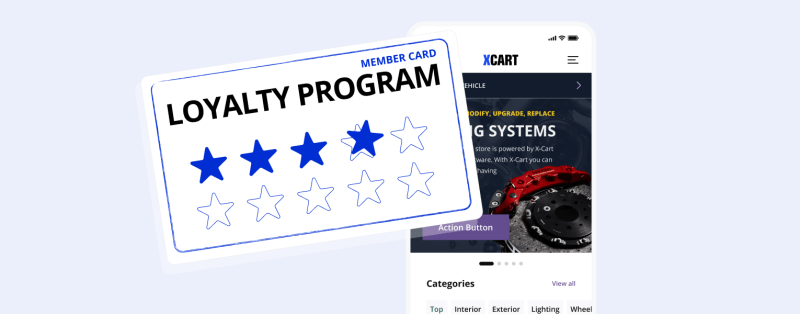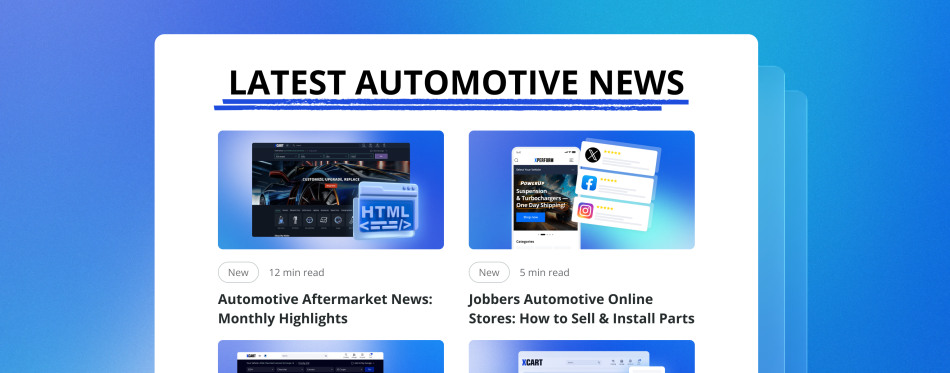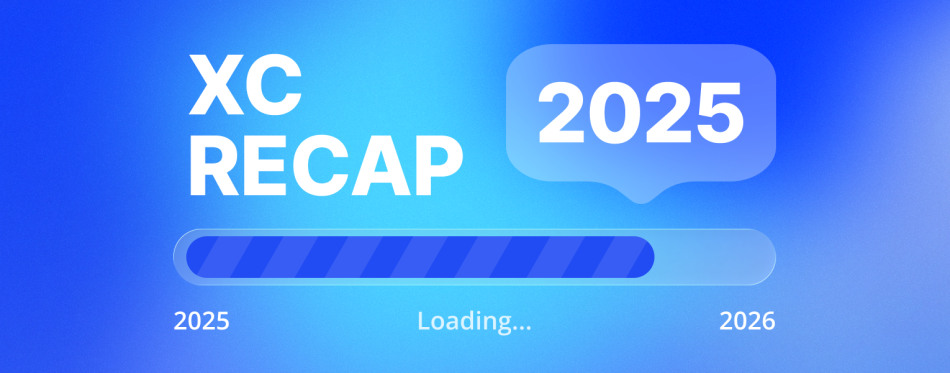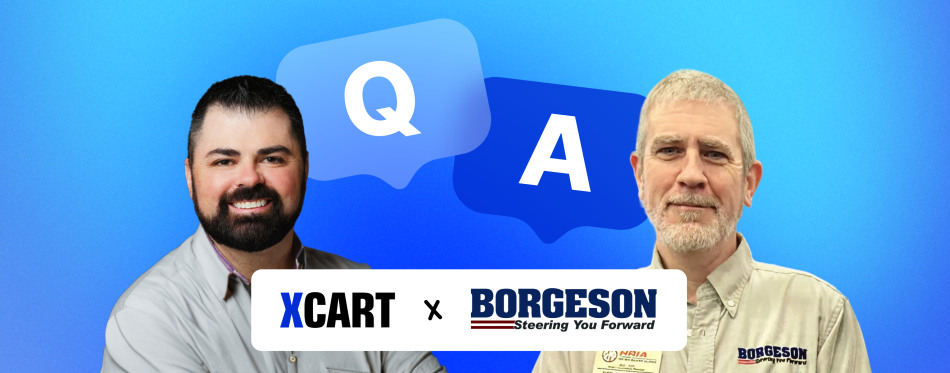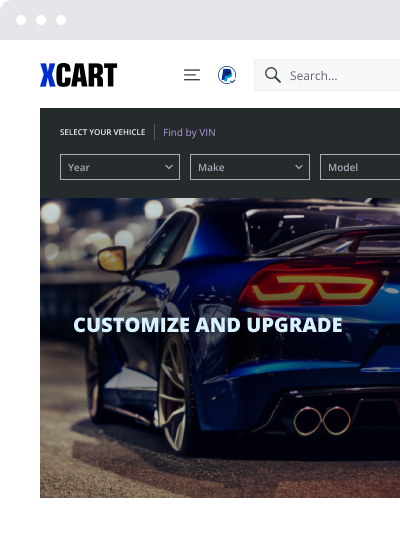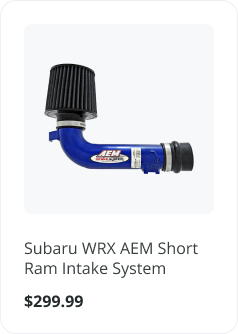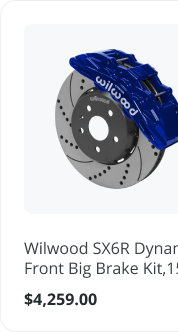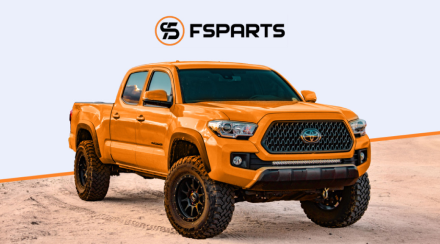Automotive Loyalty Program in an Age of Infrequent Purchases
The global automotive aftermarket is a titan, projected to surpass $950 billion by 2027. Yet, for individual auto parts eCommerce stores, it’s a fiercely competitive arena. Customer acquisition costs are perpetually rising, and the digital shelf is crowded. The most resilient and profitable businesses in this space are not the ones who shout the loudest, but the ones who build the strongest relationships. The core mechanism for this is a sophisticated data-driven automotive loyalty program.
We don’t mean generic punch cards or simple points-for-purchase schemes. The unique nature of the automotive parts industry, particularly its characteristically low purchase frequency, demands a more intelligent approach. A customer might buy brake pads today and not need another part for six months or a year.
A standard rewards program would languish, forgotten, in that interval. A properly architected program, however, turns that downtime into an opportunity to engage customers, gather data, and solidify brand loyalty.
Let’s break down the conventional wisdom and construct a foundation for a successful loyalty program that drives customer retention and maximizes customer lifetime value.
From Transactional Loyalty to Ecosystem Engagement
Historically, loyalty in the automotive sphere was straightforward. You bought a Ford, you got good service, you bought another Ford. Automotive brand loyalty was forged on the factory floor and in the dealership service bay. Today, that model is being radically deconstructed by automotive companies themselves.
Look at what car manufacturers like the Ford Motor Company are doing. The FordPass™ Rewards program is a masterclass in modern loyalty. It transcends the initial vehicle purchase. Customers earn points for buying a new car, yes, but also for servicing their vehicle at a dealership, using the FordPass Rewards Visa Card, and engaging with their connected car technology.
It’s an ecosystem designed to keep the customer within the brand’s orbit throughout their entire ownership lifecycle. Similarly, the Nissan Loyalty Program offers rewards that encourage repeat car purchase behavior, reinforcing the bond between the consumer and the brand.
This evolution provides a critical lesson for auto parts eCommerce. The customer journey is no longer a linear path from search to checkout. It’s a complex web of interactions. A DIY enthusiast might watch a 20-minute tutorial on YouTube, read three forum threads, compare prices on five sites, and then finally make a purchase.
Your loyalty program must acknowledge and reward this multifaceted customer behavior, not just the final click. The objective is to foster brand loyalty by becoming an indispensable resource, not a transactional vendor.
Architecting a High-Performance Loyalty Program for Auto Parts
A generic off-the-shelf rewards system will fail in this vertical. The key is to design a multi-layered strategy that rewards both purchases and, more importantly, engagement. A study by Bain & Company famously found that a mere 5% increase in customer retention can boost profitability by 25% to 95%. This is the metric that matters, and here is how to influence it.
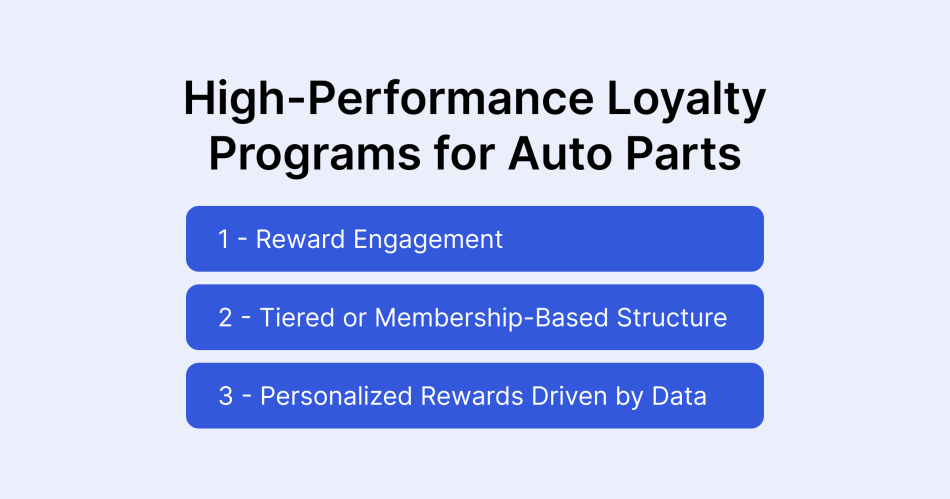
1. Reward Engagement, Not Expenditure Only
The most significant flaw in traditional programs is their silence between transactions. To combat low purchase frequency, you must create reasons to interact. This also generates invaluable customer data.
- Vehicle profile completion: The single most valuable action a customer can take is adding their vehicle(s) to their profile, the My Garage feature. This data is gold. It allows for hyper-targeted marketing and personalized service reminders. Offer a substantial block of loyalty points for this action.
- Content contributions: Reward customers for writing detailed product reviews, uploading photos of their installed parts, or answering questions from other users. This builds social proof and a community around your store, making it a resource.
- Educational engagement: Do you have video tutorials or detailed installation guides? Reward customers for watching them to completion. You will build their confidence and reduce the likelihood of returns due to installation errors.
- Referrals: Your most loyal customers are your best advocates. Implementing a referral program is a non-negotiable component of a modern loyalty strategy. It leverages existing trust to acquire new high-value customers. At X-Cart, we understand this power, which is why we have our own referral program, a proven mechanism for growth driven by your community.
2. Implement a Tiered or Membership-Based Structure
A flat points system treats every customer the same. A tiered membership-based loyalty program gamifies the experience and recognizes your best customers, encouraging aspirational behavior.
Consider a structure like this:
- Tier 1: Enthusiast:
- Standard points-per-dollar ratio.
- Exclusive discounts and member-only sale events.
- Birthday bonus points.
- Tier 2: Pro Mechanic (Achieved after a certain spend or points threshold):
- Accelerated points earning (e.g., 1.5x points).
- Early access to new product arrivals from top car brands.
- Priority service in customer support queues.
- Tier 3: Master Technician (Top 1-2% of customers):
- Highest points multiplier (e.g., 2x points).
- Exclusive access to limited-stock or high-performance parts.
- Direct line to a senior technical support specialist.
- Invitations to special online events, like a Q&A with a racing team you sponsor.
This tiered system creates a powerful psychological incentive. Customers can see the next level of benefits, motivating them to consolidate their future purchases with your store to achieve that status.
3. Leverage Data for Proactive Personalization
The data you collect from vehicle profiles and purchase history is the fuel for your retention engine. It’s time to move from reactive to proactive engagement.
Instead of just sending a generic “We miss you!” email, your system should be intelligent. An eCommerce platform like X-Cart, when integrated with a capable CRM and marketing automation suite, can power this.
Example: Your system knows a customer owns a 2019 Subaru WRX and purchased performance brake pads and rotors 24 months ago. It can automatically trigger a personalized email:
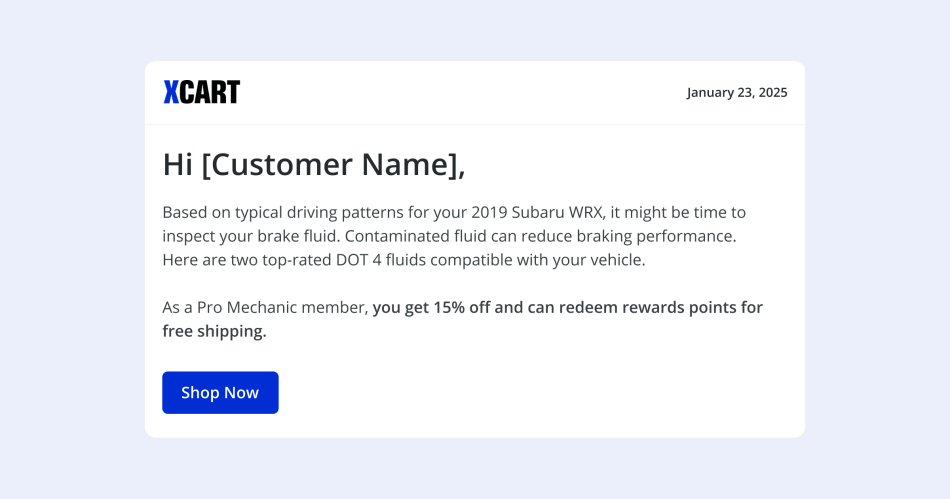
This is not marketing; this is service. It mirrors the value proposition of dealership scheduled maintenance reminders, but delivers it with the convenience and value of eCommerce. This is how you enhance customer retention.
Beyond Discounts: Coalition and Experiential Rewards
While discounts are effective, they can sometimes erode margins. The best automotive loyalty programs diversify their reward portfolio.
- Coalition loyalty programs: Forge partnerships with non-competing automotive businesses. Allow your customers to earn loyalty points in your store and redeem them for a discount on an oil change at a national chain, a subscription to a car magazine, or credit towards a car or van rental. This broadens the perceived value of your program immensely. The success of car rental loyalty programs like Enterprise Plus is built on a network of partnerships that extends their value.
- Experiential rewards: Offer rewards that money can’t easily buy. This could include:
- A free pass to a local car show or racing event you sponsor.
- A 30-minute one-on-one video call with a technical expert to plan a project build.
- Swag packs with high-quality branded tools or apparel.
- Priority roadside assistance for top-tier members.
These experiences create powerful emotional connections that a simple 10% discount never could. They are instrumental in building loyalty that is resilient to price competition.
The Technology Stack: Powering Your Loyalty Engine
An effective automotive loyalty program is more than a marketing initiative; it’s a technology stack.
- eCommerce platform: The foundation must be flexible and extensible. A platform like X-Cart provides the robust core and API capabilities needed to integrate the other components seamlessly. You need control over the customer experience and the ability to customize program rules.
- Loyalty software: Whether it’s a native module or a third-party integration, this software manages the points ledger, tier logic, and reward redemption.
- Customer relationship management (CRM): This is where your rich customer data lives. It segments customers based on their vehicle, purchase history, and engagement level, allowing for the deep personalization we discussed.
- Marketing automation platform: This system connects to your CRM and eCommerce platform to execute the personalized communications, such as the vehicle health alerts and targeted promotions, that make the loyalty program feel proactive.
This integrated approach is the only way to achieve true omnichannel loyalty programs, where the customer has a consistent, personalized experience across your website, mobile app, and email communications.
Conclusion: From Vendor to Partner
The central question is this: Is your business a transactional parts vendor or an indispensable partner in your customer’s automotive life?
A well-executed automotive loyalty program is the bridge between those two identities.
- It’s a strategic framework to systematically reinforce loyalty with every interaction.
- It transforms the challenge of low purchase frequency into a strength by creating a continuous dialogue with your customers.
- It respects the modern customer journey by rewarding engagement, not the initial purchase.
- It leverages data not to simply sell more, but to serve better, anticipating needs with personalized service reminders and offering an excellent customer service experience.
Stop focusing solely on acquiring the next customer. Start obsessing over the customer lifetime of the ones you already have. By implementing these loyalty strategies, you reward customers and build a defensible competitive advantage, turning satisfied customers into lifelong advocates.
FAQs
What are the 4 loyalty programs?
There isn’t a universally agreed-upon list of 4 specific loyalty programs. It’s more about different types or categories of loyalty programs.
Think of it like this: you’ve got point-based programs (earn points, get rewards), tiered programs (the more you spend, the better the perks), paid loyalty programs (where you pay a fee for benefits), and value-based programs (where a company aligns with your values).
Many customer loyalty programs incorporate elements from a few of these.
What are the 4 types of customer loyalty?
When we talk about customer loyalty, we often break it down into four main types.
First, there’s monetary loyalty, when customers stick around because of rewards and discounts. Then, there’s emotional loyalty, where customers feel a real connection to a brand.
Behavioral loyalty is about repeat purchases, just like when you keep buying from the same car brands. Finally, attitudinal loyalty is about a customer’s positive feelings and willingness to recommend a brand.
These different types of loyalty are super important for retaining customers and building brand loyalty.
What is the most popular loyalty program?
Point-based loyalty programs are incredibly common and widely used across many sectors, from retail to travel. In the automotive industry, for example, you might see an automotive loyalty program that offers exclusive discounts on services or future vehicle purchases.
For automotive companies, building automotive loyalty is key, even with low purchase frequency for big items like cars. What’s most popular often comes down to what best serves the customer demands and helps build customer satisfaction and strong customer engagement.
What is a loyalty offer on a car?
A loyalty offer on a car is basically a special thank-you from a car brand or dealership to their existing customers. It’s a way for them to encourage you to buy another one of their cars in the future. These offers can come in many forms, like:
- Cash back or discounts
- Special lease or finance rates
- Service perks
- Points programs
These offers aim at building brand loyalty and showing appreciation for your continued business.
What is BMW loyalty?
The actual loyalty incentives can change, but they often include:
- Loyalty credits or bonuses: These are specific amounts of money that can be applied towards the lease or purchase of a new BMW. For example, you might see a $5,000 Loyalty Bonus on certain models.
- Reduced lease payments or APR: Similar to general car loyalty offers, BMW might give loyal customers better financing or leasing terms.
- Special programs: Beyond purchasing a new car, some BMW loyalty programs, like BMW Inside Edge, focus on engaging company car drivers with exclusive rewards and access.
The goal of BMW loyalty is to make it appealing for their loyal customers to choose another BMW for their future purchases.
Need a platform for selling auto parts that understands your customer?
About the author

